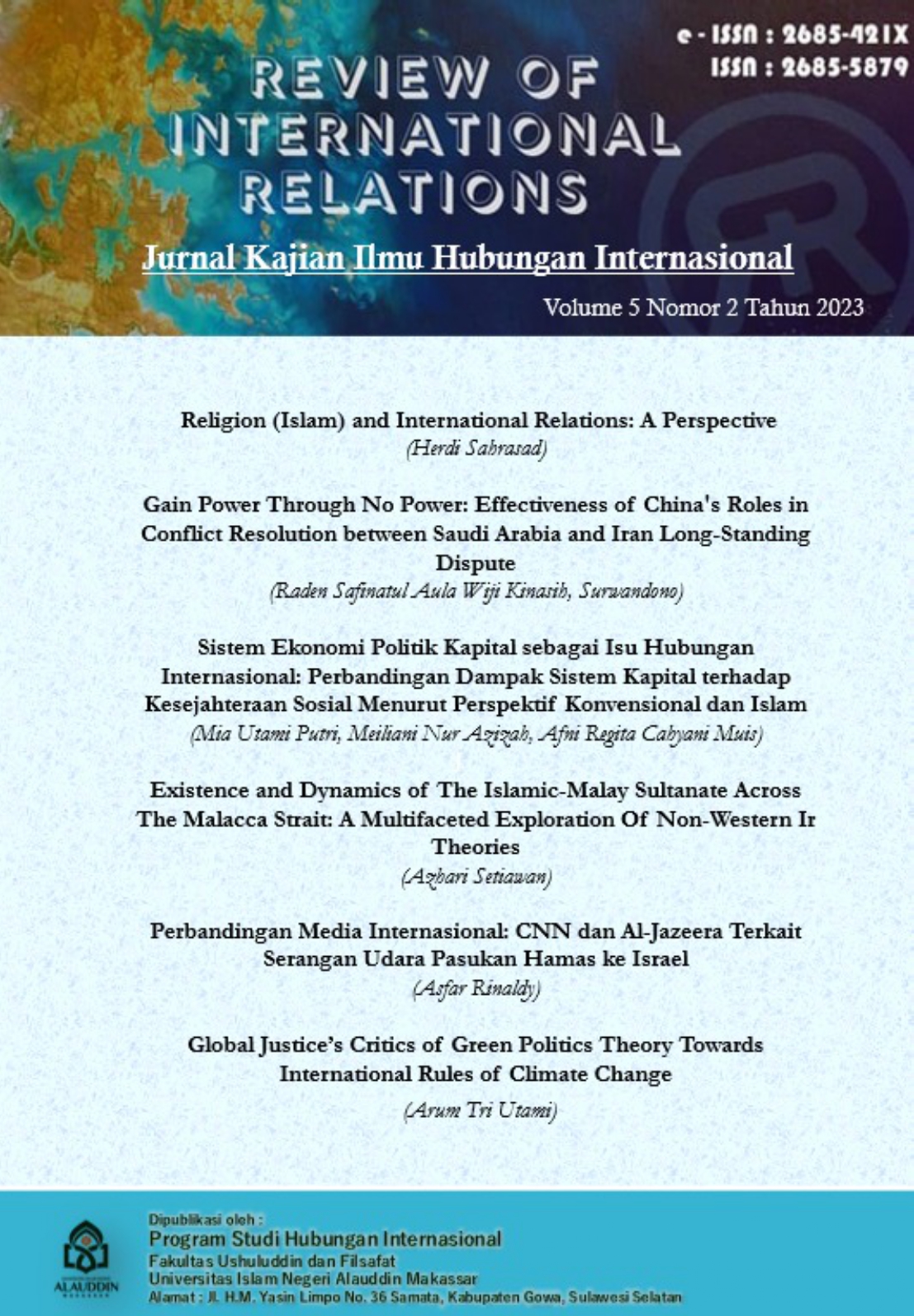Existence and Dynamics of The Islamic-Malay Sultanate Across The Malacca Strait: A Multifaceted Exploration Of Non-Western Ir Theories
Abstract
The historical interactions among the Malay sultanates/kingdoms across the Malacca Strait offer a fascinating glimpse into the world of international relations beyond the Western lens. Based on the desire to build a non-Western IR theory, this study has highlighted the rich tapestry of cultural diversity, postcolonial struggles, local agency, alternative ideas, and hybridity that characterized the diplomatic landscape of these kingdoms. The struggle for power, strategic cooperation, and regionalism among the Malay kingdoms were deeply rooted in their cultural heritage, challenging the conventional narratives, and showcasing the resilience and adaptability of non-Western societies in shaping their international relations. As we reflect on these historical dynamics, it becomes evident that the lessons from the past continue to resonate in the contemporary global landscape, emphasizing the importance of embracing diverse perspectives and recognizing the agency of all nations in shaping the course of international relations. This study delves into the intricate historical interactions among the Islamic-Malay kingdoms in the Malacca Strait region. Employing a diverse array of non-Western International Relations (IR) theories, the research sheds light on the multifaceted dimensions of the diplomatic landscape in pre-modern Southeast Asia. Through an extensive library research approach, which involved the analysis of classic manuscripts and texts relevant to the topic, this study unveils the nuanced power struggles, strategic alliances, and regional cooperation mechanisms that shaped the Malay kingdoms' international relations. By delving into these historical records, the research provides a comprehensive understanding of how cultural context, postcolonial perspectives, local agency, alternative ideas, and hybridity influenced the diplomatic maneuvers of the Malay kingdoms, challenging conventional Western-centric narratives and showcasing the richness of non-Western IR theories.
Downloads
References
Acharya, A., & Buzan, B. (2009). Non-Western international relations theory: perspectives on and beyond Asia. Routledge.
Al–Attas, S. M. N. (2011). Historical fact and fiction. Penerbit UTM Press.
Alkhateeb, F. (2017). Lost Islamic history: reclaiming Muslim civilisation from the past. Oxford University Press.
Arif, S. (2012). Islam di Nusantara: Historiografi dan Metodologi. Islamia, Jurnal Pemikiran Dan Peradaban Islam, 7(2).
Battuta, I. (2004). Travels in Asia and Africa: 1325-1354 (Vol. 18). Routledge.
Davis, J. (1880). The voyages and works of John Davis, the navigator (Vol. 2). Hakluyt Society.
De Josselin De Jong, P. E., & Van Wijk, H. L. A. (1960). The Malacca Sultanate. Journal of Southeast Asian History, 1(2), 20–29. https://doi.org/10.1017/s0217781100000119
Dunn, R. E. (2012). The Adventures of Ibn Battuta: A Muslim Traveler of the Fourteenth Century, With a New Preface. Univ of California Press.
Gibson, T. (2007). Islamic narrative and authority in Southeast Asia: from the 16th to the 21st century. Springer.
Hadi, A. (2004). Islam and State in Sumatra. https://doi.org/10.1163/9789047402046
Hall, K. (2001). Upstream and downstream unification in southeast asia’s first islamic polity: the changing sense of community in the fifteenth century hikayat raja-raja pasai court chronicle. Journal of the Economic and Social History of the Orient, 44(2), 198–229. https://doi.org/10.1163/156852001753731042
Hall, K. R. (1981). A Study of the Arabic Texts Containing Material on South-East Asia. By G. R. Tibbetts. Leiden: E. J. Brill (Royal Asiatic Society, Oriental Translation Fund, n.s., Vol. 44), 1979. xi, 294 pp. Folding Maps, Bibliography, Indexes. Dfl 72.00. The Journal of Asian Studies, 40(2), 439–441. https://doi.org/10.2307/2054935
Hill, A. H. (1960). Hikayat Raja-Raja Pasai. Journal of the Malayan Branch of the Royal Asiatic Society, 33(2 (190), 1–215.
Hill, A. H. (1963). The Coming of Islam to North Sumatra. Journal of Southeast Asian History, 4(1), 6–21. https://doi.org/10.1017/s0217781100000739
Hurgronje, S. (1925). Verspreide geschriften. https://doi.org/10.1163/9789004615359
Iskandar, T., Bakar, A., & Ahmad, Z. (1978). Hikayat Aceh: kisah kepahlawanean Sultan Iskandarmuda. Proyek Rehabilitasi dan Perluasan Museum.
Montana, S. (1997). Nouvelles données sur les royaumes de Lamuri et Barat. Archipel, 53(1), 85–95. https://doi.org/10.3406/arch.1997.3393
Panikkar, K. M. (2017). Asia & Western Dominance.
Resink, G. J. (1968). Indonesia’s history between the myths: essays in legal history and historical theory. In W. van Hoeve Publishers Ltd. Vancouver: Publications Centre, University of British Columbia. W. van Hoeve Publishers Ltd. Vancouver: Publications Centre, University of British Columbia.
Resink, G. J. (1987). Raja dan kerajaan yang merdeka di Indonesia, 1850-1910: enam tulisan terpilih. In Djambatan. Jakarta: Djambatan.
Wade, G. (1997). Melaka in Ming Dynasty Texts. Journal of the Malaysian Branch of the Royal Asiatic Society, 70(1 (272)), 31–69. Retrieved from http://www.jstor.org/stable/41493322
Wilkinson, R. J. (1935). The Fall of Malacca. Journal of the Malayan Branch of the Royal Asiatic Society, 13(2 (122)), 68–69. Retrieved from http://www.jstor.org/stable/41559840
Yule, H., & Cordier, H. (1903). The book of ser Marco Polo. The Venetian Concerning the Kingdoms and Marvels of the East, Translated and Edited with Notes, Maps and Illustrations in Two Volumes by Sir Henry Yule, London, 401.
Copyright (c) 2023 Azhari Setiawan

This work is licensed under a Creative Commons Attribution-ShareAlike 4.0 International License.










